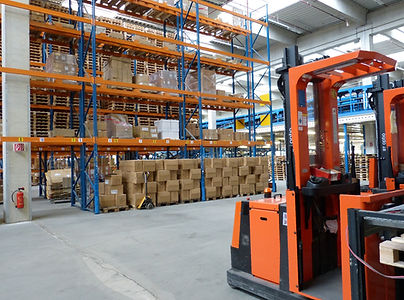
SEMA Damage Codes & Pallet Racking Tolerances Explained
Colour Coding System
Damage is recorded using a simple traffic light colour coding system. This helps identify damage levels allowing you to prioritise the risk and need for action.
Green Risk
Minor damage within the allowable limits. No remedial action is necessary but you must continue to monitor the issue at subsequent inspections. Green risks can be useful in helping you identify patterns of damage and ascertain the cause to prevent escalation of damage.
Amber Risk
Damage exceeding allowable limits requiring action or repair but not sufficiently severe to warrant immediate action. The affected location or component should be offloaded as soon as possible and not reused until repairs or rectification have been effected. If no action is taken within one month the amber risk escalates to Red risk status requiring immediate offloading of the affected location or locations.
Red Risk
A high degree of damage is noted well beyond allowable limits requiring immediate offloading of the affected location or locations and any further action as indicated in the Red Risk notice which will be issued on site. An inspection report can therefore actually contain two types of red risk:-
-
A newly identified serious risk i.e. a red risk
-
An amber risk that has been left loaded and un-rectified for over 28 days
Rack safety in the warehouse is critical for the wellbeing of warehouse workers, especially regarding pallet racking damage. The colour-coded system indicates which actions are most important. Green highlights minor damage, Amber signals the need for repair, and Red indicates severe damage requiring urgent attention. These guidelines are essential for rack systems and assessment rack of damage, including maximum allowable bends and deflection parameters, which are crucial for proactive maintenance of the warehouse. Attention to detail in inspections ensures warehouse safety standards are upheld to minimize the risk of injury.
The guidelines for assessment rack of damage:
Damage is assessed over a 1 metre section and relates to an overall bend but does not apply to dents, tears, buckles, or splits. Localised bends should be judged on a pro rata basis. Components subject to other damage such a tears and splits must be replaced.


Upright damage as viewed front to back.
For an upright bent into the rack the maximum allowable bend is 3.0mm.
Bends exceeding these limits require replacement.

Upright damage as viewed left to right.
For an upright bent in the direction of the rack (i.e. left to right as viewed from the aisle) the maximum allowable bend is 5.0mm. Bends exceeding these limits require replacement.

Frame bracing damage.
For bracing members bent in either plane the maximum allowable bend is 10mm. Bends exceeding these limits require replacement.
Assessing damage to beams or beam connectors on adjustable beam pallet racking
-
Beams will deflect naturally under normal loading conditions up to a maximum deflection of Span/200. This deflection should almost disappear once the beams are offloaded and should not be confused with permanent deformation caused by overloading or impact damage.
-
Residual vertical deformation when the beam is unloaded should not exceed span/1000 of the normal deflection under working load - see the following diagram.
-
Lateral deflection should not exceed 40% of the normal vertical deflection under working load.
-
Residual lateral deformation when the beam is unloaded should not exceed span/500.
-
Beam end connectors which show any clearly visible deformation should be unloaded and expert advice sought from the equipment supplier.
-
Welded connections between the beam section and the beam end connector should show no signs of cracking.
-
Physical alterations to beams are not permitted.
-
Where any damage is noted seek immediate advice and if in doubt, offload immediately.
-
Beams are designed for a UDL (uniform distributed load) and uneven or point loading should be avoided.
Notes on above:
If any beams are bent vertically downward when loaded by more than the beam span divided by 200, the beams should be offloaded and the pallet weights checked.
E.g. with a beam span of 2,700mm the bend when loaded should not exceed 13.5mm.
When offloaded the bending should disappear, if not DO NOT RELOAD.

Assessing deflection & damage to shelves on storage racks
The deflection of shelf edges at working load shall not exceed 1000L/C where ‘L’ is the length of the shelf in metres and where C=167 for spans greater than 2.175 metres.
For spans less than 2.175 metres C= 40(2+L).
If any shelf edges are bent vertically downward when loaded by more than these measure they should be offloaded and the shelf loading checked.
When offloaded the bending should disappear, if not DO NOT RELOAD.

